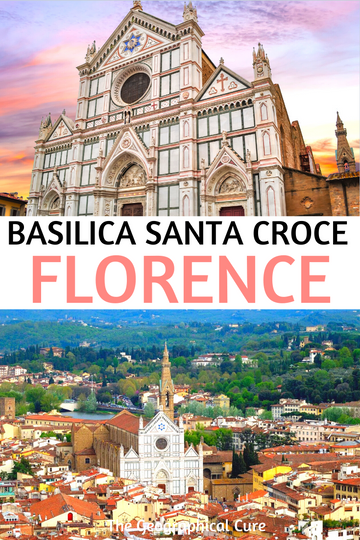In a city that’s studded with magnificent churches, Santa Croce is a place of superlatives.
The basilica has one of the greatest assemblages of paintings, sculptures, and funereal monuments in existence. It’s home to celebrity tombs, magnificent frescos, and Donatello sculptures.
The basilica is a place of one stop shopping for Italian culture and a must see attraction in Florence for art lovers.
In this Santa Croce guide, I tell you everything to see in the basilica and give you must know tips for visiting.
Tickets & Tours For Santa Croce
Should you pre-book a ticket?
Yes, you’ll need one in high season unless you can brave the lines. Click here to book a skip the line ticket.
You may want to book a guided tour of Santa Croce. You can also book a guided tour of Santa Croce and its ancient leather shop.
Guide To Santa Croce: What To See
What should you make sure to see inside the Santa Croce complex? Let’s take a tour of the renowned basilica.
Santa Croce is filled with so many Renaissance treasures, there’s a lot to cover — chapels, Donatello sculptures celebrity tombs, and works from the basilica’s museum.
1. Santa Croce’s Chapels
Frescoed chapels were a common feature of Franciscan churches. The great families of Florence commissioned the top artists of the time to decorate their chapels.
Much of the 14th century frescos survive today, although some were damaged, lost, or restored.
There are 16 chapels in Sant Croce. I’ll focus on the five most significant ones.
2. Bardi Chapel: Giotto Frescos
The Bardi, an aristocratic banking family, hired Giotto to decorate their family chapel, just to the right of the choir. Giotto was the greatest painter of the 14th century and a founder of Western art as we know it.
In 1320-28, Giotto painted seven episodes from the life of St. Francis of Assisi, whom he personally identifed with. You read them from right to left, top to bottom.
The frescos show Giotto’s innovative nature. The figures depart from the figurative stiffness characteristic of medieval times. They have an intensely emotive faces.
Giotto’s figures are depicted as compassionate, even appearing to cry at St. Francis’ death. The Santa Croce frescos are the highest point of Giotto’s pictorial work. Generations of future artists were to come to Santa Croce to admire and learn from them.
The precious frescos were painted over in the 18th century. They were rediscovered in the 19th century. But an ineffective rework damaged them. Hence, today there are some empty patches.
3. Peruzzi Chapel: Giotto Frescos
The Peruzzi Chapel features Giotto’s first work in Santa Croce. Giotto covered the chapel with stories of St. John the Baptist and St. John the Evangelist.
Sadly, the fresco are in poor condition. Giotto painted them in the secco fresco technique, where the plaster is allowed to dry before the oil paint is applied. This is easier than true fresco, painted on wet plaster. But it’s much less durable.
Painted 30 years earlier, the Peruzzi frescos are less impressive than the Bardi frescos. Those are livelier and more dramatic.
Still, it’s believed that both Masaccio and Michelangelo studied the Peruzzi frescos.
4. Pazzi Chapel
In 1442, the Pazzi family constructed the Chapter House, used by the Franciscan friars, in the church’s medieval cloisters. It was later known as the Pazzi Chapel.
The chapel was reputedly designed by Filippo Brunelleschi, the founding father of Renaissance architecture.
The Pazzi were a notorious Florentine family. In 1478, they tried, but failed, to oust the ruling Medici family in a coup.
READ: Nutshell History of the Medici
They plotted to kill both Lorenzo and Giuliano Medici. But Lorenzo, known as Lorenzo the Magnificent, escaped and exacted revenge.
The Pazzi Chapel is considered one of the most harmonious buildings of the early Florentine Renaissance. It’s decorated not with frescoes, but with glazed terra cotta roundels created by Luca della Robbia and his followers.
5. Baroncelli Chapel
Construction of the Baroncelli Chapel began in 1328. It’s one of the best preserved chapels in Santa Croce.
It boasts attractive frescoes by Taddeo Gaddi, a student, collaborator, and godson of Giotto.
It also has a beautiful altar, stained glass window, and ceiling cupola. The fresco cycle was executed between 1328 and 1338 and represents the stories of the Virgin Mary.
Gaddi also designed the stained glass.
6. Maggiore Chapel
This chapel has frescos by Taddeo Gaddi’s son, Agnolo Gaddi.
Agnolo was considered the artistic heir of Giotto. It was the last and largest chapel in Santa Croce to be decorated. Gaddi created a massive fresco, The Legend of the True Cross.
The colorful fresco tells the story of Christ’s cross. Legend holds that the cross was made from a tree planted over Adam’s grave.
READ: Guide To Piero della Francesca’s Legend of the True Cross Fresco Cycle in Arezzo
The fresco is notable for details and curiosities that have nothing to do with the legend’s iconography. It’s like a treasure hunt. You can spot animals, flora and fauna, and portraits of Taddeo, Agnolo, and Giotto.
In 2006, the chapel was closed for 5 years for restoration. Now, the colors glow luminously.
7. Donatello’s Sculptures
Santa Croce has three of Donatello’s monumental sculptures.
Donatello was the most influential sculptor of the 15th century. He had a profound effect on Michelangelo and later generations of Renaissance artists.
Donatello was the first sculptor to move away from Gothic depictions. He re-introduced elements from the classical Greco-Roman sculpture he studied in Rome.
Donatello departed from the prevailing flat iconography. He sought to depict the human experience, producing natural and highly emotional works.
St. Louis of Toulouse, 1425
St. Louis of Toulouse is Donatello’s earliest surviving bronze sculpture. Donatello tells the story of the humble friar who abdicated his throne for the church.
Louis wears the sandals of a Franciscan friar. St. Louis’s gesture of blessing and the drapery of his attire show a classical influence.
This sculpture is found in the Santa Croce Museum.
Annunciation, 1435
This magnificent Donatello sculpture sits casually on a church wall near the Cavalcanti Chapel. The Annuncation — when Mary learns that she will bear Christ — is one of the most common Renaissance themes.
The sculpture is lavishly gilded. Donatello departs from prior depictions of the Annunciation with strong realism and a psychological narrative.
Mary isn’t portrayed as divine, but as a woman startled by the angel Gabriel.
Crucifix, 1406-08
Santa Croce’s wooden crucifix is one of Donatello’s finest works. Christ is bearded, tanned, muscular, and sorrowful.
It’s a far cry from the usual idealized depictions. Though a friend of Donatello, Brunelleschi accused him of “crucifying a peasant.”
8. Santa Croce’s Celebratory Tombs
Santa Croce is also known as the “Temple of Italian Glories.” If you love Renaissance masters and luminaries, you can pay homage to them here.
Santa Croce is filled with celebrity tombs, perhaps only eclipsed by the Basilica-Cathedral of St. Denis in Paris.
There are over 300 tombs honoring artists of the Renaissance era. Some of the floor tombs are so old, you’re not allowed to walk on them. I’ll focus on the most significant ones.
Michelangelo’s Tomb
Michelangelo may be the world’s most famous artist, showing virtuosity in every medium. His Santa Croce tomb was designed by his fanboy, Giorgio Vasari.
Legend holds that Michelangelo chose the site for the tomb, so that on Judgment Day the first thing he would see was Brunelleschi’s dome on Florence Cathedral.
Vasari was the world’s first art historian, most famous for his book The Lives of the Artists. Though Vasari provided valuable insight into the goings on of the Renaissance, he was a mediocre artist and lacked the power of Michelangelo.
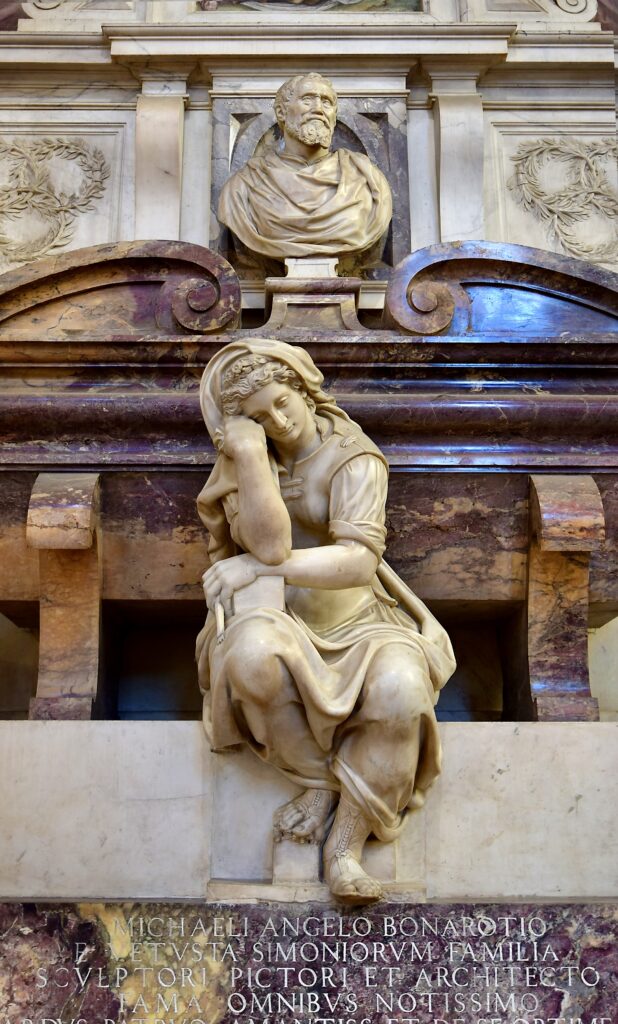
His tomb for Michelangelo, while well meaning, is static and not quite fitting for one of the greatest artists of all time. It’s an allegory of sculpture, architecture, and painting — three things at which Michelangelo excelled.
Frescos are at the top, there’s a bust of Michelangelo, and below that 3 crying women representing his artistic disciplines.
Michelangelo lived his life between Florence and Rome due to his commissions, most famously completing the Sistine Chapel in the Vatican.
He spent his last 30 years in Rome. When he died, his heir spirited his body out of Rome and transported it to Florence so Michelangelo could be put to rest in the city he loved most.
READ: Guide To the Michelangelo Trail in Florence
Galileo’s Tomb
Galileo’s tomb, designed by Giovanni Batista Foggini, is directly across from Michelangelo’s tomb. The great astronomer died in 1642.
If you look closely, you’ll see that his tomb dates from 1737. Galileo wasn’t buried in Santa Croce initially.
When Galileo proclaimed that the earth revolved around the sun, he got in a heap of trouble. Under pressure, his “friend” Pope Urban VIII made Galileo recant his scientific findings.
Galileo was tried by the Inquisition and exiled from Florence. During the Age of Enlightenment, scholars realized that he was right all along. His remains were then moved back to Florence.
Lorenzo Ghiberti’s Tomb
The church also houses the tomb of Lorenzo Ghiberti. Ghiberti created the famous bronze doors of the Baptistery of Florence Cathedral, which Michelangelo dubbed the “Gates of Paradise.”
The doors there now are reproductions, with the originals housed in the Duomo Museum.
Ghiberti’s tomb is simple. It’s marked by the emblem of an eagle on the floor.
Nicollo Machiavelli’s Tomb
Machiavelli was the father of political theory. You may remember him from phrases like “the ends justify the means.”
He wrote The Prince, a handbook for political rulers expounding on the cynical mechanics of statecraft. The Medici took The Prince to heart.
Dante Alighieri’s Memorial
The incredible Tuscan poet Dante lived in Florence his first 37 years. But then he was exiled for his political activities.
He died in Ravenna, where he wrote his most famous work, The Divine Comedy.
Florence nonetheless claims his poetic legacy. There’s an honorary tomb for Dante in Santa Croce, though the sarcophagus is empty.
It’s on the south wall, near Michelangelo’s tomb. His tomb shows a pensive Dante flanked by allegories of poetry and Italy.
Leonardo Da Vince Plaque
No, da Vince is not buried in Santa Croce! Though the plaque honoring him may lead you to think so. Da Vinci spent the last years of his life in France’s Loire Valley and died in Amboise.
READ: Guide To the Paintings of Leonardo da Vinci
Gioachino Rossini’s Tomb
Nicknamed the “Italian Mozart,” Rossini was a composer in the Classical period of the 19th century.
His most famous pieces were the William Tell Overture and the opera The Barber of Seville. While not a Renaissance luminary, Rossini was the most popular composer of his time.
Rossini died in Paris. He was initially buried in Paris’ Pere Lachaise Cemetery. Nine years alter, his body was transferred to Santa Croce. His tomb shows a muse lamenting his demise.
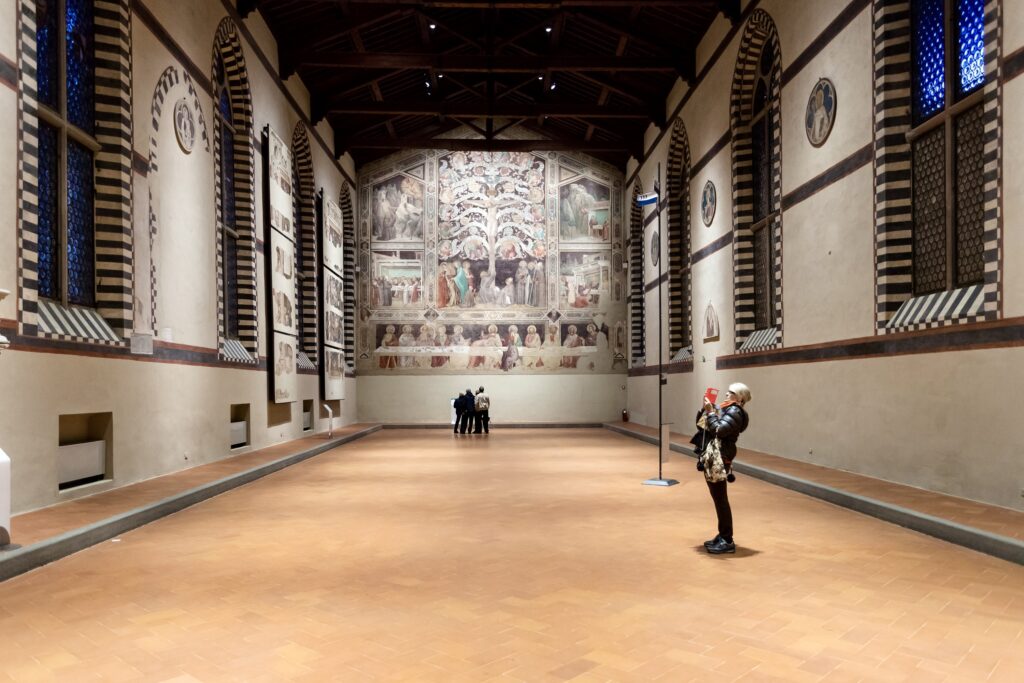
9. Santa Croce Museum | Museo dell’Opera di Santa Croce
Like Florence Cathedral, Santa Croce has its own museum. Founded in 1900, the Santa Croce Museum is in the church’s former Refectory. It houses works from the Florentine school.
In 1966, the space was damaged by catastrophic flooding of the Arno River. It was carefully restored, though some damage was irreversible. The museum reopened in 1975.
In the museum, you’ll find many frescos, sculptures, sketches, etc. Here are some of the best artworks:
Crucifix of Cimabue, 1280
Cimabue’s Crucifex may be Santa Croce’s greatest masterpiece. Cimabue was a great painter of the 13th century.
He bridged the gap between Italo-Byzantine art and the Renaissance. Cimabue influenced early Renaissance artists like Giotto. Vasari refers to Cimabue as “the first page of Italian art.”
The Crucifix was painted in distemper on wood. It’s an image of a suffering and dying Christ, flanked by saints. The faces are extremely expressive.
The flood almost completely destroyed the painting, with a loss of 60% of the painted surface. The piece came to symbolize the tragic losses suffered by Florence, and is a reminder of harm from disasters.
In 1976, the Crucifix underwent a massive restoration, which fixed some of the irreparable damage.
Taddeo Gaddi, The Last Supper and the Life Tree, 1335
On the west wall, there’s a vast painting of the Last Supper. It’s executed by Taddeo Gaddi, one of Giotto’s best pupils. Appropriately, it’s located in the former dining hall of the friars.
The Last Supper depicts the moment when Jesus announces he’ll be betrayed by one of his apostles. Judas is shown with his back to us and isolated from his companions, suggesting his guilt.
Above the Last Supper, Gaddi paints the Tree of Life. The mystical tree is surrounded by scenes of St. Francis and Mary Magdalen.
READ: All The Last Supper Paintings of the Italian Renaissance
Bronzino, Christ’s Descent into Limbo, 1552
Agnolo di Cosimo di Mariano, called Bronzino, was a famous Mannerist artist, from the late Renaissance. This devotional painting, a large altar piece, is from the Old Testament.
In it, Christ is depicted as descending into hell or limbo to rescue deserving people.
You can see Bronzino’s portrayals of Adam and Eve, Noah, Judith, Isaac, David, Abraham, etc. The painting also includes likeness of Bronzino’s Florentine contemporaries and a self portrait of Bronzino himself. At the time, it was controversial for its evocative erocticism.
The piece was also damaged in the great flood of 1966. But it was skillfully restored and appears almost brand new.
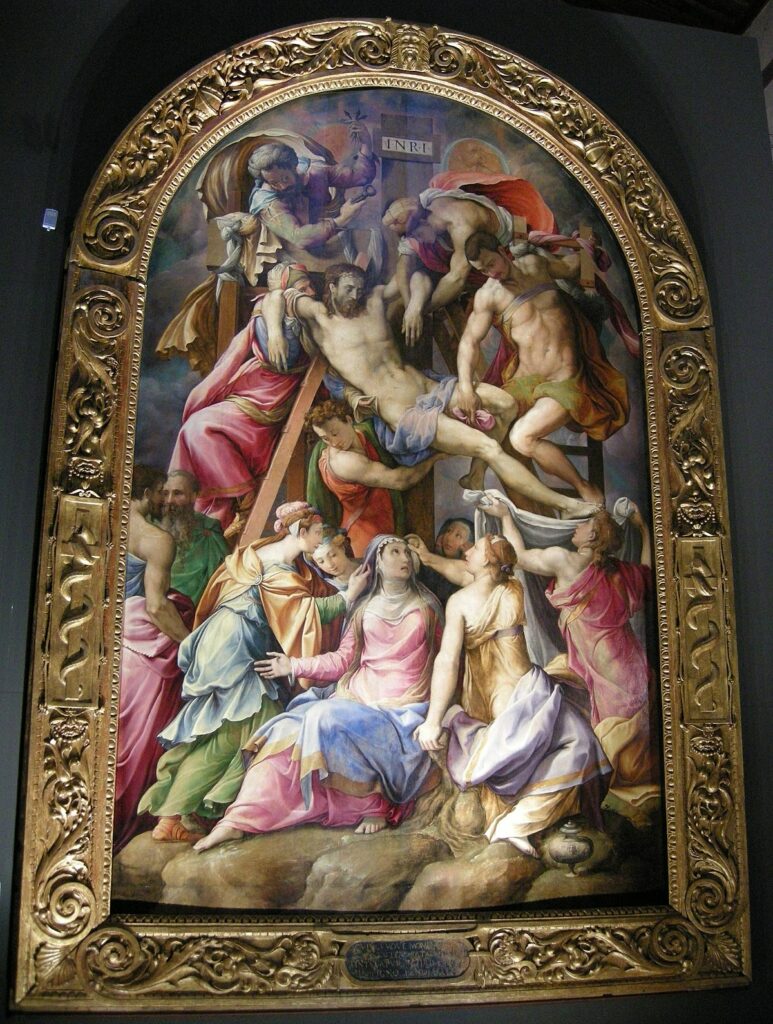
Francesco Salviati, Deposition from the Cross, 1547-48
Like Bronzino, Salviati was an Italian Mannerist painter, also known as Francesco de’Rossi and Il Salviati.
The Deposition was Salviati’s most important easel painting. Typical of the Mannerists, there’s an extreme artificiality in the positioning of the figures and a refined and polished appearance.
Practical Guide & Tips For Santa Croce
Address: Piazza di Santa Croce 16 Florence
Hours: Monday to Saturday 9:30 am to 5:00 pm, 2:00 to 5:30 pm on Sundays
Entry fee: 8 euros. The ticket includes access to the entire Santa Croce complex — the basilica, the museum, the cloisters, and the Pazzi Chapel
Orientation: If you’re traveling alone, you’ll enter through a side door. To your right is the facade. To your left is the high altar. Group tours enter through the front door.
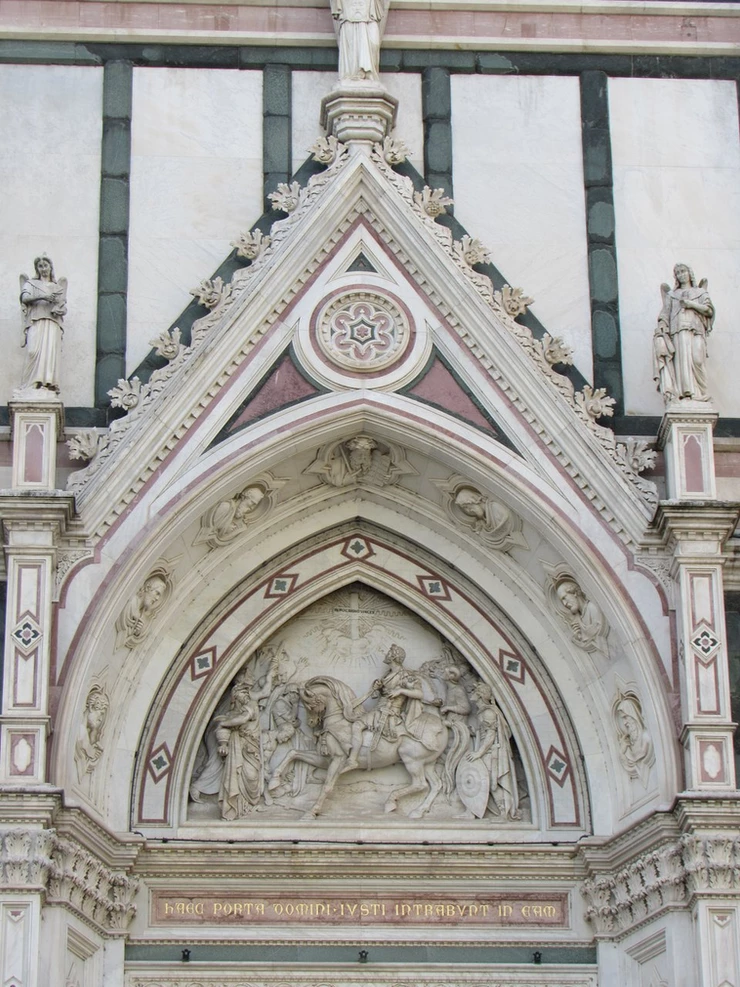
Pro tip: You won’t be allowed inside unless you’re dressed appropriately. So don’t wear short shorts or sleeveless tops.
I hope you’ve enjoyed my guide to the Basilica of Santa Croce. You may enjoy these other Florence travel guides and resources:
- 1 day itinerary for Florence
- 3 day itinerary for Florence
- Best museums in Florence
- Hidden gems in Florence
- Must see attractions in Florence
- Florence art bucket list
- Best day trips from Florence
- Guide to the Medici Palaces
- Guide to the Uffizi Gallery
- How To Visit the Florence Duomo
If you’d like to visit the Basilica of Santa Croce in Florence, pin it for later.

